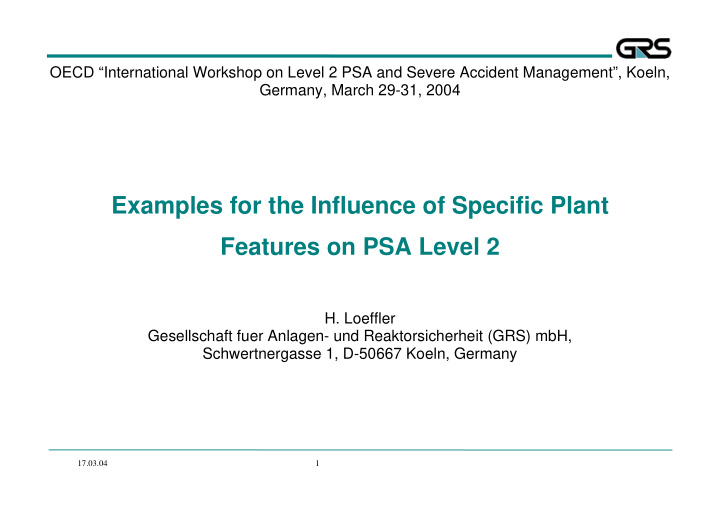



OECD “International Workshop on Level 2 PSA and Severe Accident Management”, Koeln, Germany, March 29-31, 2004 Examples for the Influence of Specific Plant Features on PSA Level 2 H. Loeffler Gesellschaft fuer Anlagen- und Reaktorsicherheit (GRS) mbH, Schwertnergasse 1, D-50667 Koeln, Germany 17.03.04 1
Introduction This presentation intends to demonstrate those “hidden” plants features may exist which have significant impact on the PSA. GRS has performed PSA level 2 for the following reactors: - 1300 MWe BWR with concrete containment and an inner steel liner - 1400 MWe PWR of the “Konvoi” type - 960 MWe BWR with steel containment (PSA to be completed end 2004) From these analyses five examples for specific plant features have been selected, with following characteristics: - can significantly influence accident progression and PSA Level 2 results. - is plant specific - might easily have been ignored in the PSA 17.03.04 2
Example 1: Single closed drain opening at the RPV bottom of a BWR determines failure mode of RPV lower head There is a large number of control rod and instrumentation penetrations which might resist core melt attack for some time One single penetration in center of bottom is closed by tube stub with cover (detail E) Consequences: • This penetration will fail soon after contact with core material -> any other failure mode is meaningless • This penetration cannot be cooled by flooding the RPV from below -> this accident mangement measure would fail • Early local failure of RPV will prevent later large scale high pressure failure -> overall risk is lower due to this detail. 17.03.04 3
Example 2: RPV support structure of BWR influences lower head coolability External flooding of the RPV is foreseen in this reactor to mitigate consequences of core melt at RPV bottom. Close inspection of critical locations revealed that there is no significant flow path along the violet arrow. Consequences: • Steam which would be generated at the RPV bottom would form a bubble and prevent cooling of upper outer part (red arrow) of lower head. • Most likely RPV failure mode with bottom cooling would be circumferential break at hottest part. • Most likely RPV failure mode withot bottom cooling would be local failure. • Mitigating effect of flooding is questionable. 17.03.04 4
Example 3: Ventilation ducts in concrete basemat below reactor cavity determine corium relocation and possible containment failure in a PWR There are ventilation ducts (about 30x50 cm² each) in the concrete basemat.Together with pressure equalizing flaps they are potential pathways for the core material. • Initially the ventilation ducts will be filled with sump water. • Core concrete interaction in the dry cavity inspection door (closed) pressure equalising flap (open) reaches the ventilation ducts • Corium might flow to the containment sump. • In the containment sump is a cavity which corium ventilation ducts is not coolable. Might be the position of the first bottom penetration. particle bed sump • Interactions between core material, sump suction pipe concrete and water will produce particles which will settle into the sump suction lines, creating a threat to the containment. 17.03.04 5
Example 4: Hydrogen threatens containment venting system of a PWR After RPV failure the core concrete interaction continuosly produces large amounts of noncondensible gases (left figure). The oxygen is Loss of AC power 0 min Begin core melting 2h 35min consumed by the autocatalytic recombiners. Failure of surge line 2h 55min RPV failure 6h 22min Sump water contakt 10h 07min Containment venting 45h 00min When containment venting is initiated, the H 2 - and CO-mass (10 3 kg) atmosphere contains about 10% of H 2 , and 75% of steam. Downstream a venturi scrubber the steam is almost zero and the H 2 fraction is 40%. In most German plants the venting exhaust is led in a separate line to the top of the stack. In this plant the exhaust is directed into off-gas ducts of the auxiliary building. Highly inflammable gas mixtures will develop there during many hours, threatening the auxiliary building, the venting filter and the stack. Influence on releases is significant Time (h) 17.03.04 6
Example 5: Natural draft driven gas flow through the stack determines fission product release in a BWR After containment bottom failure (blue arrow) some doors (red arrows) will be damaged due to pressure waves, including H 2 burns, creating flow paths from the interior of the buildings to the environment. Check flaps are inserted in the ducts from the buildings X into the stack ( X ). When the ventilation fans are shut down in an accident the flaps close. One might suspect that releases are directed through the damaged doors. The natural draft developed by the stack (green arrow) would push open the check valves. A gas flow develops through the damaged doors from the environment into the buildings, and out of the stack. Large volumes of the rooms and the long flow path lead to a significant reduction of releases. Releases are at stack height instead of door height. 17.03.04 7
Summary Some plant specific features have been shown which can significantly influence accident progression and PSA Level 2 results: - Closed drain openings at the bottom head of the RPV - RPV support skirt in a BWR - Ventilation ducts in the concrete floor below the reactor cavity - Position of the exhaust from the containment venting system - Natural draft driven mass flow through the stack and the ventilation These issues had not been expected at the beginning of the PSA. They rather had been detected later during the PSA process. There is no guarantee that all relevant issues have been identified. The PSA team should be given sufficient time to familiarize with the plant and it should have resources available to deal with uncommon topics. 17.03.04 8
Recommend
More recommend